Detail sanders, often overlooked in the realm of power tools, are an essential component for any craftsman, DIY enthusiast, or professional woodworker. These compact and versatile tools are designed to reach into tight corners and intricate spaces where larger sanders cannot. They provide the precision and control necessary for fine sanding, making them indispensable for detailed work.
The purpose of this article is to delve into the world of detail sanders. We will explore their functions, the need for them in various projects, the different types available, and the key features to consider when purchasing one. This comprehensive guide aims to equip you with the knowledge to choose the right detail sander for your needs.
Our Top Detail Sander Picks
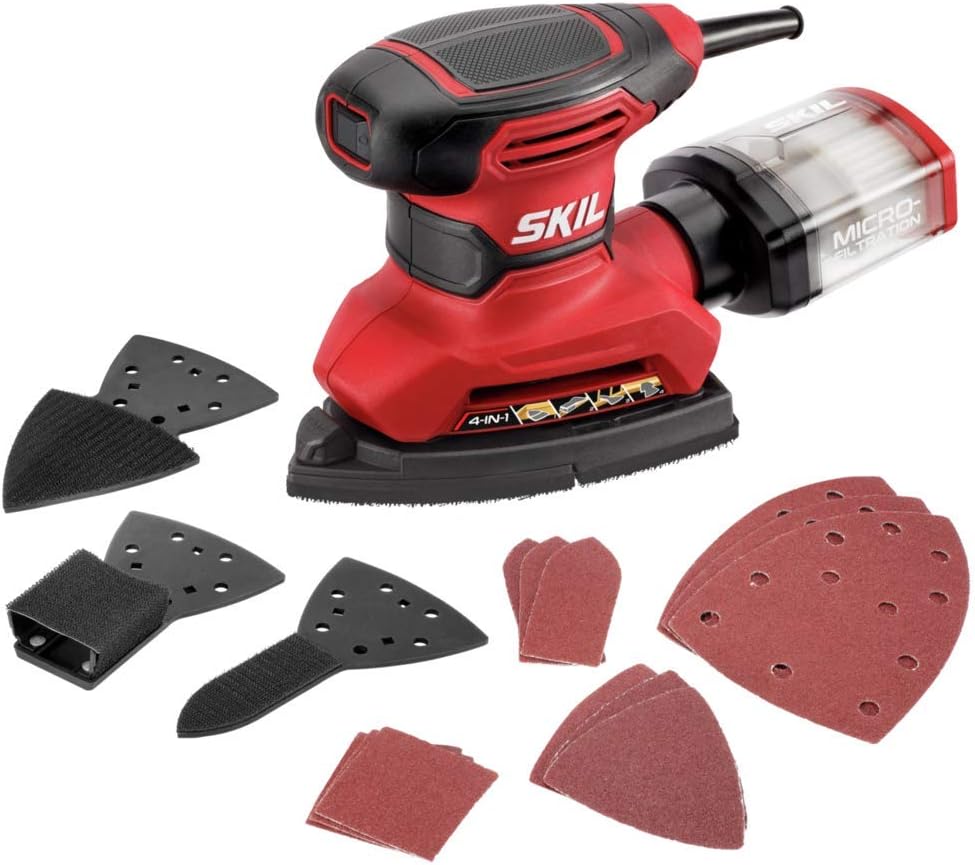
SKIL Corded Multi-Function Detail Sande
Check on AmazonKey Specs
- Motor Power: 1.2 amps, 13,500 orbits per minute
- Versatility: Includes 3 detail attachments for different sanding needs
- Dust Management: Micro-filtration system and vacuum port for dust control
- Easy Sheet Change: Hook-and-loop system for quick sanding sheet swaps
- Ergonomic Design: Low vibration and soft rubber grip for comfort
The SKIL Corded Multi-Function Detail Sander is an excellent tool for tackling a variety of sanding jobs with ease. The 1.2 amp motor delivers a smooth performance at 13,500 orbits per minute, ensuring a fast and efficient finish. What sets this sander apart is its 4-in-1 versatility, with three additional detail attachments for fine finishes on large surfaces, corners, edges, and contours. I also appreciate the dust-management system with a vacuum port and ergonomic design that reduces hand fatigue, allowing me to work longer without discomfort.
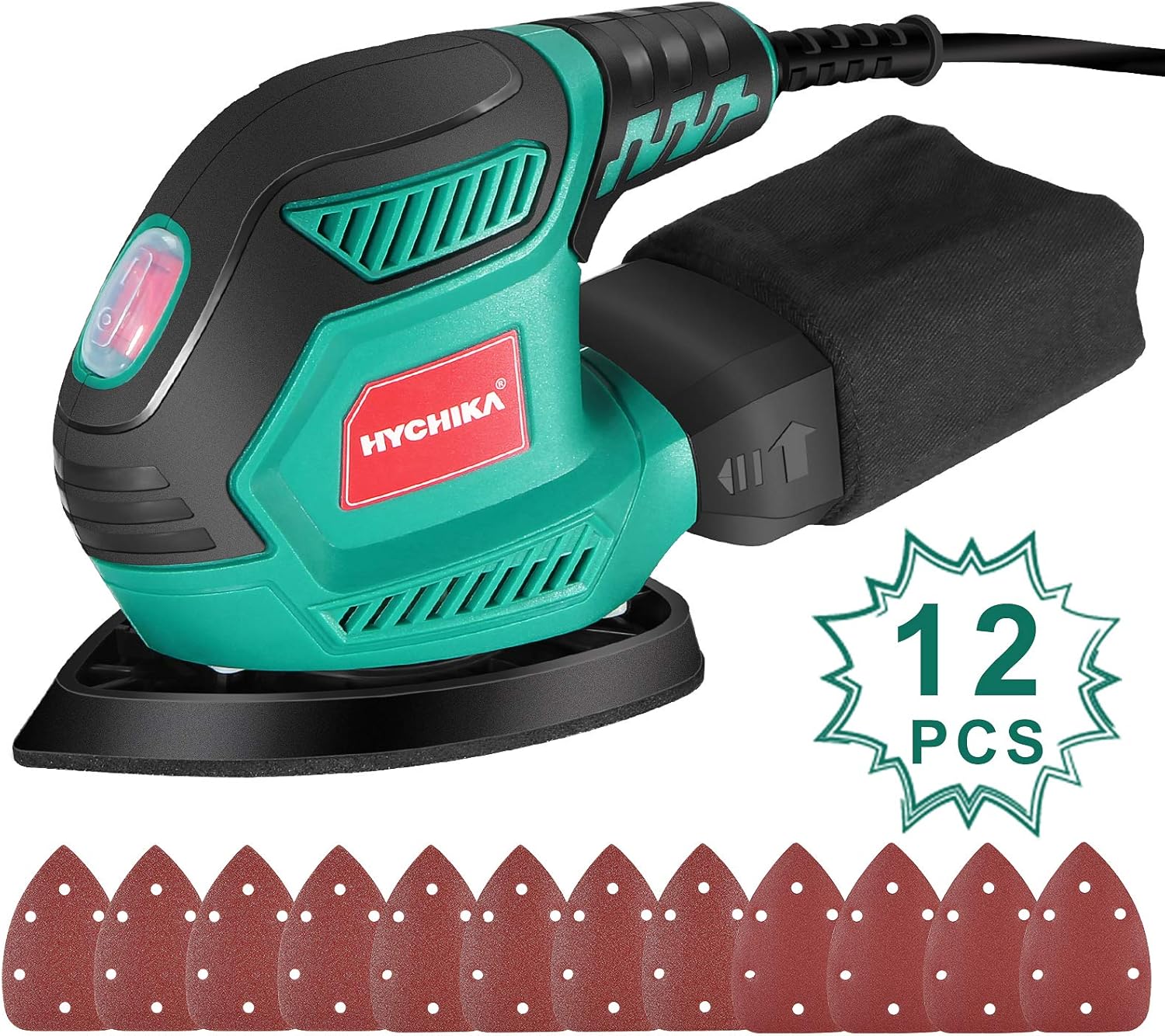
HYCHIKA Detail Sander
Check on Amazon
Key Specs:
- Motor Power: 1.6 amps, 14,000 orbits per minute
- Sanding Paper: 12 sheets in P80/P120/P240 grit for versatile use
- Dust Collection: 6-hole dust system and included dust bag
- Ergonomic Design: Compact and soft rubber grip for comfort
- Cord Length: 2 meters for added reach
The HYCHIKA Detail Sander stands out for its quiet and efficient operation, running at 1.6 amps and reaching up to 14,000 orbits per minute. This makes it perfect for tasks like polishing metal, stripping paint, and removing rust from small, hard-to-reach areas. The included 12 sheets of sanding paper in P80, P120, and P240 grits ensure you’re ready for various tasks, while the 6-hole dust collection system keeps your workspace clean. Its ergonomic design with a soft rubber handle ensures comfort during extended use.
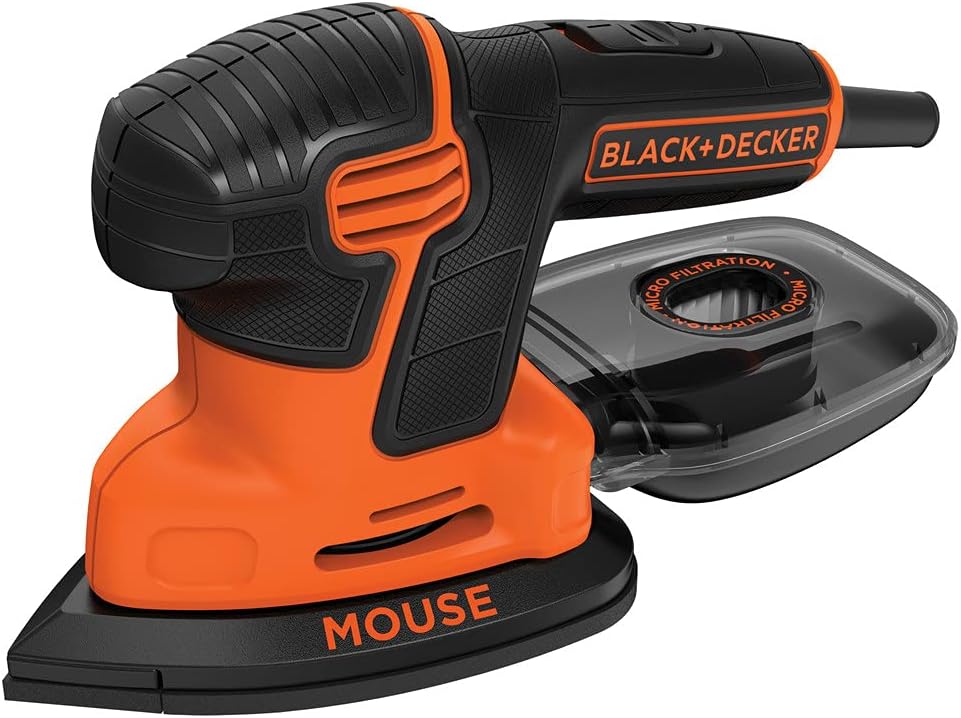
BLACK+DECKER Detail Sander
Check on Amazon
Key Specs:
- Motor Power: 1.2 amps, 16,000 orbits per minute
- Dust Collection: Micro-filtration system with canister
- Grip: 3-position grip for versatile control
- Attachment: Includes detail finger attachment for tight spaces
- Corded: Unlimited runtime for extended use
The BLACK+DECKER Detail Sander offers an ideal solution for tight spaces with its compact design, allowing access to cramped corners and hard-to-reach areas. Powered by a 1.2-amp motor delivering 16,000 orbits per minute, it provides fast and efficient material removal. The interchangeable detail finger attachment further enhances its versatility. For a cleaner work environment, the dust collection canister with a micro-filtration system keeps debris at bay. Its 3-position grip ensures control, while the hook-and-loop system makes sandpaper changes effortless.
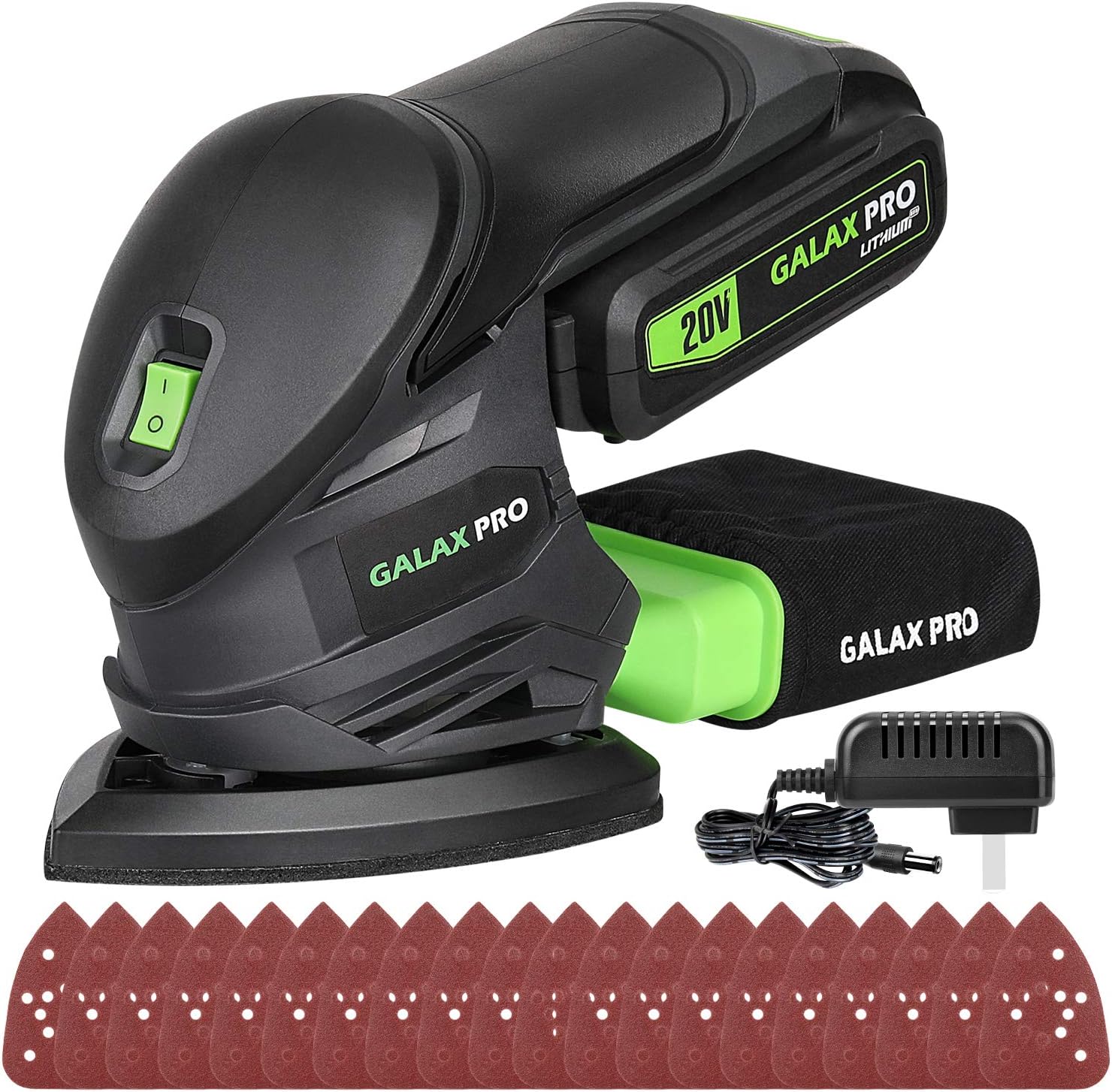
GALAX PRO Cordless Detail Sander
Check on Amazon
Key Specs:
- Voltage: 20 volts
- Motor: Copper motor for more power and less heat
- Sandpaper: 20 pieces (5 each of 60, 80, 100, and 120 grains)
- Dust Collection: Includes dust collection bag for a clean workspace
- Ergonomics: Soft rubber grip for comfortable, prolonged use
The GALAX PRO Cordless Detail Sander combines a powerful 20-volt battery with a copper motor, delivering more power and less heat compared to traditional copper-clad aluminum motors. This sander is perfect for removing paint or working on tight spaces thanks to its ergonomic design and compact size. It includes 20 pieces of sandpaper for versatile use and a dust collection system that keeps your workspace clean. The self-adhesive sandpaper discs make changes quick and easy, while the dust-sealed switch ensures durability.
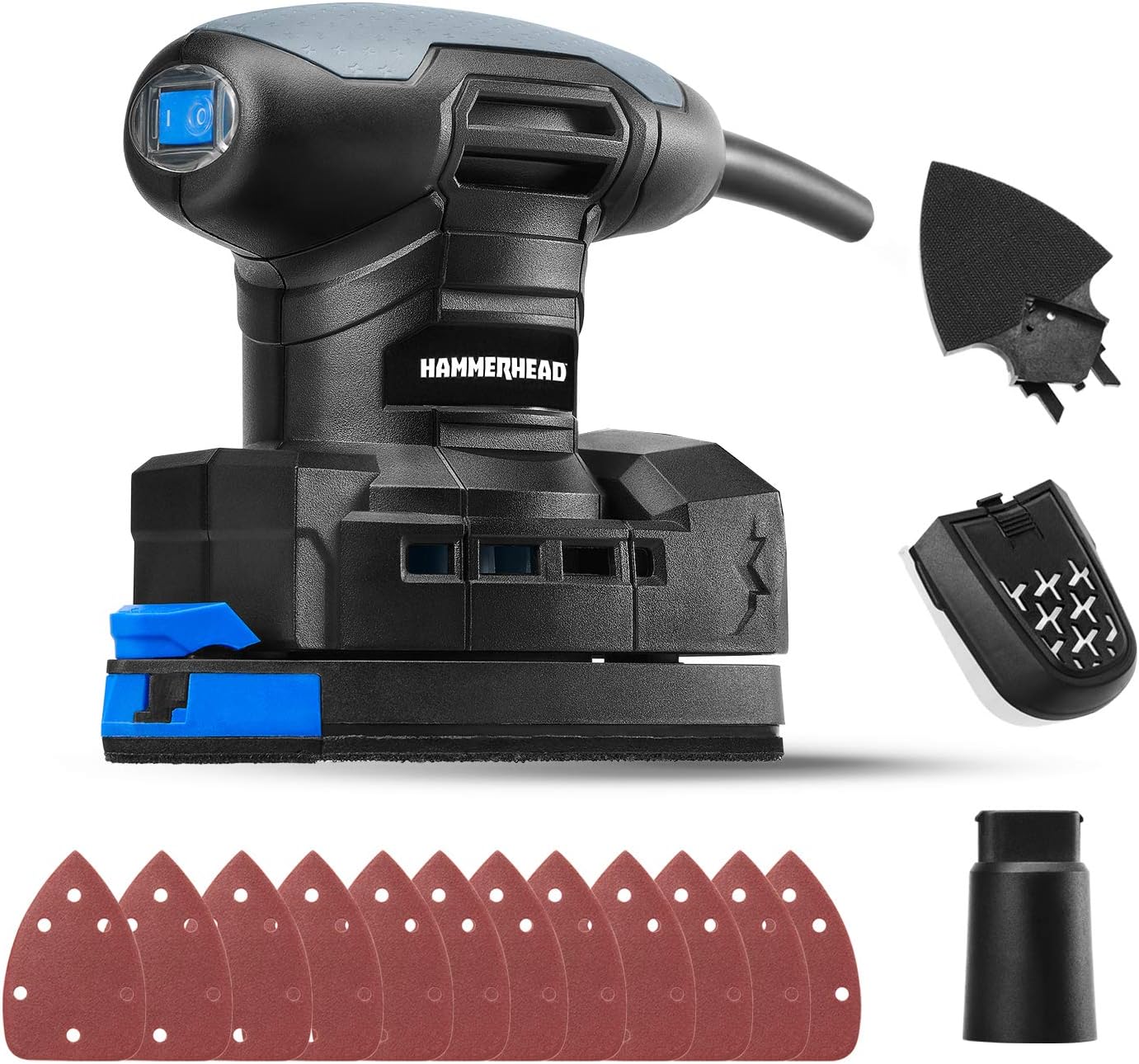
Hammerhead 1.4-Amp Multi-Function Detail Sander
Check on Amazon
Key Specs:
- Motor: 1.4-Amp
- Speed: 12,000 OPM
- Detail Attachment: Tool-free, triangular design
- Dust Management: Includes dust box and vacuum adaptor
- Switch: Dust-sealed for extended performance
The Hammerhead 1.4-Amp Multi-Function Detail Sander is designed for precision and efficiency. With its 1.4-Amp motor and a rotation speed of 12,000 OPM, it delivers consistent, long-lasting performance. The triangular detail attachment is easily swapped without tools, allowing you to reach tight corners and intricate spaces. Its hook-and-loop system makes sandpaper changes quick and easy. Plus, the included dust management system keeps your workspace clean, with a dust-sealed switch for enhanced durability.
Understanding Detail Sanders
A detail sander, also known as a mouse sander due to its small size and pointed tip, is a power tool used for sanding. It is designed to sand tight corners and intricate spaces that are typically hard to reach with larger, more conventional sanders. The compact design and precision of a detail sander make it an essential tool for any detailed woodworking or craft project.
The importance of precision in fine sanding cannot be overstated. Detail sanders provide the control and accuracy needed to create a smooth, flawless finish. This is particularly important in projects that involve delicate materials or intricate designs, where a slight mistake could ruin the entire piece.
The Need for Detail Sanders
Detail sanders are required for a variety of specific projects. They are commonly used in furniture restoration, where they can easily reach into the tight corners of drawers and cabinets. Model builders also rely on detail sanders to achieve a smooth finish on their miniature creations. In addition, they are ideal for craft projects that involve intricate designs or delicate materials.
The benefits of using detail sanders for fine sanding are numerous. They allow for a high level of precision and control, resulting in a smoother, more professional finish. They also save time and effort, as they can easily reach into tight spaces without the need for manual sanding. Furthermore, their compact size makes them easy to handle and maneuver, reducing the risk of fatigue during prolonged use.
Types of Detail Sanders
There are several types of detail sanders available on the market, each with its own set of features and uses. The most common types include the orbital detail sander, the oscillating detail sander, and the multi-tool detail sander. Orbital detail sanders move in a circular motion, making them ideal for removing large amounts of material. Oscillating detail sanders move back and forth, providing a high level of precision for fine sanding. Multi-tool detail sanders, as the name suggests, can perform a variety of tasks, including cutting, scraping, and sanding.
When comparing the features and uses of different detail sanders, it’s important to consider your specific needs and preferences. For instance, if you require a tool for heavy-duty sanding, an orbital detail sander may be the best choice. On the other hand, if precision is your top priority, an oscillating detail sander could be more suitable. And if versatility is key, a multi-tool detail sander might be the ideal option.
Power Source for Detail Sanders
Detail sanders can be either corded or cordless, each with its own set of advantages and disadvantages. Corded detail sanders are typically more powerful and can run continuously without the need for recharging. However, they require a power outlet and can be less convenient to use due to the cord. Cordless detail sanders, on the other hand, offer greater mobility and flexibility, but they may not be as powerful and their runtime is limited by the battery life.
When choosing between a corded and cordless detail sander, it’s important to consider your specific needs and circumstances. If you plan to use the tool for prolonged periods or heavy-duty tasks, a corded model might be the best choice. However, if mobility and convenience are more important, a cordless model could be more suitable.
Key Features to Consider when Buying a Detail Sander
When purchasing a detail sander, there are several key features to consider. The power and speed of the tool will determine its performance and efficiency. Higher power and speed typically result in faster and more effective sanding, but they can also make the tool harder to control. Therefore, it’s important to find a balance that suits your specific needs and skill level.
The size and weight of the detail sander can also affect its usability. A compact and lightweight model is easier to handle and maneuver, especially in tight spaces or during prolonged use. However, it may not be as powerful or durable as a larger, heavier model. Another important feature to consider is dust collection. A detail sander with a good dust collection system can keep your workspace clean and reduce the risk of respiratory problems.
Comfort and ease of use are also crucial factors. Look for a detail sander with an ergonomic design and user-friendly features, such as an easy-to-change sandpaper system or a variable speed control. These features can make the sanding process more comfortable and efficient, especially for beginners or those with limited experience.
Top Brands of Detail Sanders
There are several leading brands in the detail sander market, each with its own strengths and weaknesses. Some of the top brands include Black & Decker, Bosch, Makita, and Dewalt. Black & Decker is known for its affordable and user-friendly tools, making it a popular choice among DIY enthusiasts. Bosch offers a range of high-quality and innovative tools, while Makita is renowned for its durable and reliable products. Dewalt, on the other hand, is a favorite among professionals due to its powerful and high-performance tools.
When comparing the products and reputation of different brands, it’s important to consider your specific needs and budget. For instance, if you’re a beginner or on a tight budget, Black & Decker might be the best choice. However, if you’re a professional or require a high-performance tool, Dewalt could be more suitable. It’s also worth checking user reviews and ratings to get a better idea of the performance and reliability of different brands and models.
Price Range of Detail Sanders
The price range for detail sanders can vary greatly depending on the brand, model, features, and quality. Basic models can be found for as low as $20, while high-end models can cost over $100. On average, a good-quality detail sander can be purchased for around $50 to $70.
Several factors can influence the price of a detail sander. The brand and model are obvious factors, with well-known and reputable brands typically charging more for their products. The features and specifications of the tool can also affect the price. For instance, a detail sander with a high power output, variable speed control, and a good dust collection system will likely cost more than a basic model. The quality and durability of the tool are also important factors, with higher-quality models generally being more expensive.
Where to Buy Detail Sanders
Detail sanders can be purchased from a variety of sources, both online and in physical stores. Online retailers such as Amazon and eBay offer a wide range of products from different brands, often at competitive prices. They also provide user reviews and ratings, which can be helpful when choosing a product. Physical stores, on the other hand, allow you to see and handle the product before purchasing, which can be beneficial if you’re unsure about the size or feel of the tool.
When buying a detail sander, whether online or in a physical store, it’s important to do your research and compare prices. Look for reputable sellers and check their return policy in case the product doesn’t meet your expectations. It’s also worth considering the warranty offered by the manufacturer, as this can provide peace of mind in case of any defects or issues with the tool.
User Reviews and Ratings
Checking user reviews and ratings is an important step when buying a detail sander. They can provide valuable insights into the performance, reliability, and usability of the tool, which can help you make an informed decision. However, it’s important to take these reviews with a grain of salt, as they can sometimes be biased or inaccurate.
When interpreting and using user reviews and ratings, it’s important to look for patterns and common issues. For instance, if several users complain about the same problem, such as a weak motor or poor dust collection, it’s likely a legitimate concern. On the other hand, if a negative review is an outlier, it might be due to a defective unit or user error. It’s also worth considering the overall rating of the product, as a high rating generally indicates a good-quality tool.
Safety Tips when Using Detail Sanders
Like any power tool, detail sanders should be used with caution to prevent accidents and injuries. Basic safety precautions include wearing protective gear, such as safety glasses and a dust mask, and keeping the work area clean and well-lit. It’s also important to keep the tool well-maintained, as a poorly maintained tool can be dangerous and less effective.
Proper maintenance of a detail sander involves regular cleaning and inspection. The sandpaper should be replaced as soon as it becomes worn or ineffective, and the dust collection bag or filter should be emptied regularly to ensure optimal performance. The tool should also be inspected for any signs of damage or wear, such as a frayed cord or loose parts, and repaired or replaced as necessary.
Conclusion
In conclusion, detail sanders are an essential tool for any craftsman, DIY enthusiast, or professional woodworker. They provide the precision and control necessary for fine sanding, making them indispensable for detailed work. When choosing a detail sander, it’s important to consider the type, power source, key features, brand, price, and user reviews. By doing your research and considering your specific needs, you can find the perfect detail sander for your projects.
Remember, safety should always be a priority when using power tools. Always wear protective gear, keep your workspace clean and well-lit, and maintain your tool properly to ensure its longevity and safety. With the right detail sander and safety precautions, you can achieve a smooth, flawless finish on your projects with ease and efficiency.
Appendix: Detail Sander Models Comparison Chart
For a detailed comparison of different detail sander models, please refer to the comparison chart provided. This chart includes ratings and reviews for each model, allowing you to compare their performance, reliability, and value for money at a glance.
Appendix: Frequently Asked Questions about Detail Sanders
For answers to common questions about detail sanders, please refer to the FAQ section. This section provides clear and concise answers to questions about the use, maintenance, and safety of detail sanders.
Appendix: Glossary of Terms Related to Detail Sanders
For explanations of technical terms related to detail sanders, please refer to the glossary. This glossary provides definitions and explanations of terms such as “orbital”, “oscillating”, “multi-tool”, “corded”, “cordless”, and “dust collection”, helping you understand the features and specifications of different detail sanders.
FAQ
What is a detail sander?
A detail sander is a small, lightweight power tool designed for sanding in tight spaces, corners, and intricate areas that are hard to reach with larger sanders.
How does a detail sander work?
It uses a vibrating or oscillating sanding pad to smooth surfaces, and the compact design allows for precise control in detailed work.
What is a detail sander used for?
It’s ideal for fine sanding tasks such as furniture refinishing, sanding around trim, or working on delicate woodwork and carvings.
Can a detail sander be used on all surfaces?
Detail sanders are typically used on wood, but with the right sandpaper, they can also work on metal, plastic, and painted surfaces.
Is a detail sander easy to use?
Yes, its lightweight design and ergonomic grip make it user-friendly, especially for tasks that require precision and control.
